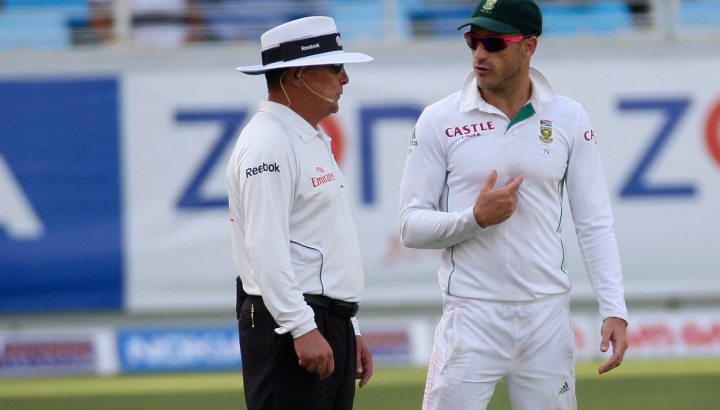Sport
Analysis: Ball tampering is a legal, not a moral issue

For Faf du Plessis life goes on. Or it will, eventually. For now, Du Plessis and South Africa find themselves the eye of a storm in a teacup, after he pleaded guilty to ball tampering. His crime: an aggressive rubbing of a ball against the zipper of his pocket. He may have escaped with a light sentence but the incident once again opened the debate over tampering and punishment. By ANTOINETTE MULLER
Faf du Plessis, and arguably the rest of the South African team, find themselves in the spotlight for all the wrong reasons. Forget their impeccable record of not having lost a series away from home since 2006, second only to the West Indies who managed 18 unbeaten series between 1980 and 1997 and forget their 100 wins since readmission. They’ve lost just 50 Tests of the 207 they’ve played since then. Forget that they became the first Test team to ever beat Pakistan in Dubai. For some, all the glory of their latest victory will be overshadowed by an incident involving ball tampering.
Du Plessis has been fined 50 percent of his match fee after pleading guilty to the offence, but the furore does not stop there. Since Du Plessis was spotted on TV cameras rubbing the ball on his trousers close to the zip, or even on the zip, outrage has gripped those who want to hold cricket up as a moral benchmark of sorts.
“Cheats” is the word with which South Africa has been branded by some and for the more cynical, every single one of their impressive bowling performances will now be thought of as dubious. It’s a tag which might trail them for a while, but it’s a rather unnecessary tag.
The Oxford dictionary says that cheating is: to act dishonestly or unfairly in order to gain an advantage. There is nothing dishonest about altering the state of the ball. In the current age of a batsman-friendly game, you’d be hard pressed to argue that a bowler trying to get one over his opponent who already has a large number of factors in his favour, is acting unfairly.
The law regarding altering the state of the ball says: It is unfair for anyone to rub the ball on the ground for any reason, to interfere with any of the seams or the surface of the ball, to use any implement, or to take any other action whatsoever which is likely to alter the condition of the ball, except as permitted in the stipulated laws.
The problem comes with policing the law. It is near impossible to have a consistent judgement about “deliberate interference” with the surface of the ball. Teams often deliberately throw the ball into the pitch, let it crash into the boundary boards. Teams are warned against this before the start of every game, yet, they still do it.
In some cases like an incident involving Stuart Broad a few years ago, some teams even deliberately trod on the ball with their spikes. Even South Africa have been in this boat before. In 1997, Hansie Cronje was seen stamping on a ball with his studs during a crowd interruption in Australia, but no action was taken. Players use all sorts of substances and get away with it because the alteration is hardly noticeable, even when foreign materials are used.
In that way, the law in itself presents a challenge – the inconsistency in its application removes the legal issues and makes it a moral one instead. Some of this so-called “cheating” is acceptable because it can be disguised or is sometimes ignored and glossed over, yet when it is searched for and exposed, it becomes a moral disgrace.
The Du Plessis incident only really came to light when it was shown by TV cameras. The Daily Maverick understands that it was one of the TV commentators who suggested to the director that Du Plessis should be followed. That is quite common practice and a similar thing happened with Sachin Tendulkar in 2001 in South Africa. Tendulkar started bowling, got the ball to swing and the local TV producer instructed cameramen to zoom in on Tendulkar’s hands, ostensibly to check what grip he was using.
Instead of spotting his grip, he was spotted digging is fingernail into the seam of the ball. The result was similar to what happened in Dubai. The repeat was shown over and over again and the commentators went into overdrive. Every team is likely to have a designated “shiner” – and it’s not hard to spot who it is. Whether it was a commentator or producer who suggested cameras follow Du Plessis hardly matters – somebody knew what to look for and they made sure it was spotted: whatever the agenda behind that was is irrelevant, but it did create a storm in a tea cup.
It’s not like the ICC aren’t aware of what happens either. Zips – the culprit of alternation in question in the Du Plessis incident – will be banned from cricket kits as of 2015. That suggests that there have been suspected incidents of untowardness happening involving these little fashion ensembles for a while now. And that really shouldn’t be a surprise.
Working a ball, or making the ball work for you, is common practice. Everybody does it. The art of reverse swing is an intricate and complex one, but in an overtly batsman-friendly game, it’s a necessary skill and an enchanting form of dark arts. Of course a line needs to be drawn somewhere – nobody wants pen knives on the boundary edge – but before that’s even considered, the inconsistent punishment for the offence needs to be addressed.
According to ICC laws, changing the condition of the ball is a level two offence. That offence falls in the same category as public criticism of a match-related incident or match official, amongst other things. Also under level two offence is any attempt to manipulate a match in regard to the result (in a negative way), net run rate, bonus points or otherwise. (eg. intentionally losing so that a team will face a weaker opponent in the semi-finals.)
That those three incidents fall in the same category should speak volumes in terms of seriousness of offences. All of the above offences carry the punishment of a fine of 50% to 100% of match fee and/or ban for one Test or two ODIs.
Du Plessis escaped with a 50 percent fine, unlike Pakistan’s Shahid Afridi, who was banned for two games for biting a ball three years ago. Both incidents were blatant, both incidents should have carried the same punishment.
The discrepancy in punishment is galling and Pakistan will be seeking clarification as to why it was so. The most likely answer is that the two different match referees had a difference in opinion on the state of seriousness. Since one person’s opinion on the incident is taken into account, perhaps one should also consider how reputations perceive certain groups of players. Quite like in soccer where one “bad egg” player is likely to receive a harsher punishment than the other, there is the erroneous perception that certain groups of players are more prone to get up to mischief. This presents a problem which can be easily solved – a uniformed policy for “tampering”.
Umpires are there to do a job – one of them is to check the ball. If they feel the ball has been changed too much, replace it and award five penalty runs in shorter formats and a larger margin in Tests. As for the tamperers, ensure they are all treated the same way and that repeat offenders are sanctioned. Ensure, though, that the benchmarks for what constitutes significant altering are clear and that these are uniformly executed along with their punishments. It will also require some more cunning policing from officials and TV producers.
Perhaps, if the art of moulding the ball and shaping it to better suit bowlers is put out in the open and better explained to the average punter, tampering will eventually be de-stigmatised and people will better understand the art of reverse swing, thus opening a wider debate around the different skills bowlers employ in order to baffle batsmen.
The case for “legalising” tampering is contentious as deciding where to draw the line is complex. That might change in the future, but while the practice is inconsistently punished and certain instances are ignored, it will only do more harm to a sport that already has enough far more serious challenges to deal with. DM
Photo: South Africa’s Faf du Plessis (R) talks to umpire Ian Gould (L) during the fourth day of the second test cricket match against Pakistan in Dubai October 26, 2013. REUTERS/Nikhil Monteiro



















